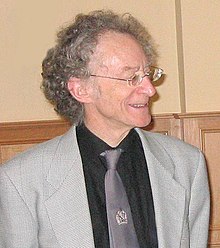| Robin BatterhamAO FAA FTSE | |
|---|---|
 Robin Batterham, 2005, wearing an IChemE tie Robin Batterham, 2005, wearing an IChemE tie | |
| Born | (1941-04-03) 3 April 1941 (age 83) Brighton, Victoria, Australia |
| Alma mater | University of Melbourne |
| Scientific career | |
| Fields | Chemical engineering |
| Institutions | CSIRO Rio Tinto |
Robin John Batterham (born 3 April 1941) is an Australian scientist specialising in chemical engineering. He was the Chief Scientist of Australia from 1999 to 2006.
Born in the Melbourne suburb of Brighton, Batterham graduated from the University of Melbourne in 1965 with a degree in chemical engineering, and received a PhD from the same institution in 1969. He received a scholarship from the Commonwealth Scientific and Industrial Research Organisation (CSIRO) to undertake postgraduate studies at the central research laboratories of ICI in the United Kingdom. Batterham returned to Australia in 1970, and took up the position of chief scientist of the CSIRO's Division of Mineral Engineering, and was later promoted to division chief.
In 1999, he was appointed Chief Scientist of Australia, a role which he undertook simultaneously to acting as chief technologist for the multinational mining company Rio Tinto. Supporters of renewable energy technologies claimed that Batterham's employment by a mining company made his advice to the Prime Minister on climate change and geosequestration questionable, although Batterham assured his critics that his advice and work as Chief Scientist was neutral and not affected by his Rio Tinto position. In 2004, concern was expressed over Dr. Batterham's dual roles, and a Senate committee found that there was a conflict of interest between the two, recommending that the Chief Scientist position be made full-time. In May 2005, Batterham stepped down as Chief Scientist and took on a full-time position at Rio Tinto.
From May 2004 to May 2005, Batterham was President of the Institution of Chemical Engineers.
Batterham was elected a member of the National Academy of Engineering in 2004 for the modeling of iron ore systems and team leadership in the development of innovative industrial metallurgical processes. He was appointed an International Fellow of the Royal Academy of Engineering in 2004. He was also appointed a Fellow (FTSE) of the Australian Academy of Technological Sciences and Engineering (ATSE) in 1988, and served as its President 2007–2012. in 2014 the Batterham Medal was established in his honour by ATSE as an early career award in the field of engineering.
Batterham is the assistant organist at Scots' Church, Melbourne. He has given numerous organ recitals, and has released several CDs.
References
- ^ Dr Robin Batterham, University of Melbourne.
- Batterham, Robin John (1941 – ), Bright Sparcs (University of Melbourne), 13 December 2006.
- Fowler, Andrew: Questions raised over chief scientist's Rio Tinto role, The 7.30 Report (ABC), 8 December 2003.
- Guerrera, Orietta: Chief scientist's dual roles 'damaging', The Age, 6 August 2004.
- Barlow, Karen: Australia's Chief Scientist gives up Govt position for mining giant, AM (ABC Radio), 17 May 2005.
- The Chemical Engineer, June 2004, p 21 "High Flier has landed" (interview)
- ^ "List of Fellows". Archived from the original on 8 June 2016. Retrieved 24 October 2014.
- Robin Batterham appointed ATSE President, Australian Academy of Technological Sciences and Engineering, 2007.
- "History of the Batterham Medal". Australian Academy of Technology and Engineering. 14 November 2018. Archived from the original on 4 June 2021. Retrieved 10 June 2021.
- "Music". Scots' Church, Melbourne. Archived from the original on 22 January 2011. Retrieved 21 January 2011.
| Government offices | ||
|---|---|---|
| Preceded byJohn Stocker | Chief Scientist of Australia 1999–2005 |
Succeeded byJim Peacock |
- 1941 births
- Living people
- People educated at Brighton Grammar School
- University of Melbourne alumni
- Chief Scientists of Australia
- Australian chemical engineers
- Australian mining engineers
- Imperial Chemical Industries people
- Officers of the Order of Australia
- Australian classical organists
- Male classical organists
- Fellows of the Australian Academy of Technological Sciences and Engineering
- Fellows of the Australian Academy of Science
- Foreign members of the Chinese Academy of Engineering
- 21st-century Australian public servants
- 21st-century Australian engineers
- 20th-century Australian engineers
- 21st-century organists
- 21st-century Australian male musicians
- 21st-century Australian musicians
- People from Brighton, Victoria
- Scientists from Melbourne